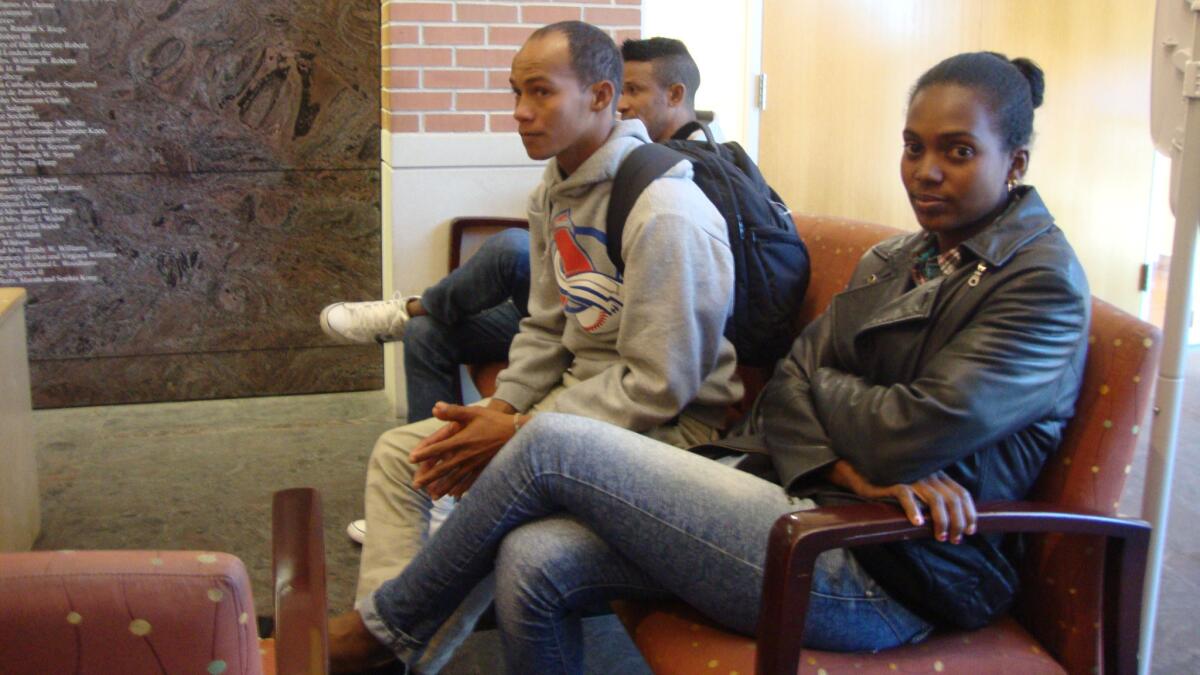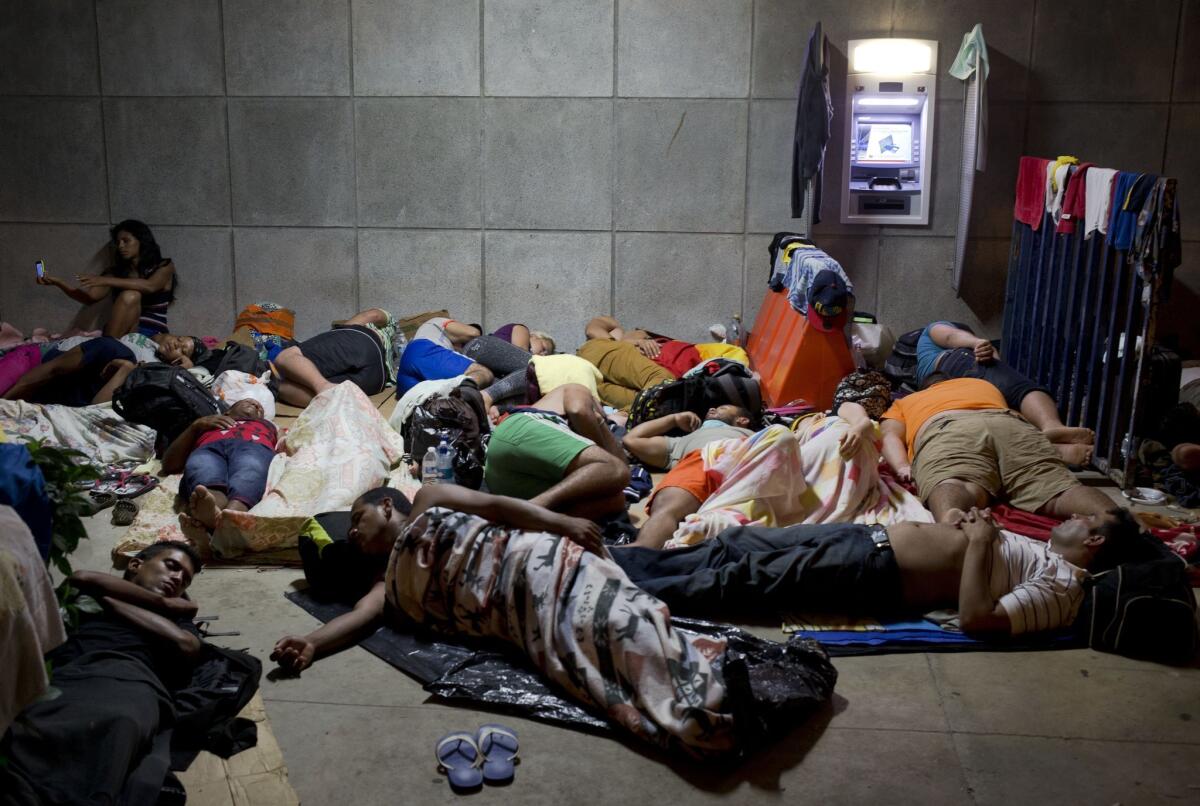New wave of Cuban immigrants reaches U.S., but through Texas, not Florida

Jordanis Perez, 31, center, waits for help at Catholic Charities in Houston with fellow Cuban immigrants.
- Share via
Reporting from Houston — When Jordanis Perez fled Havana this spring for the United States, he decided his best chances weren’t by boat to Florida, but by a route increasingly favored by thousands of Cuban migrants— by land to Texas.
The number of Cubans arriving at the southern border increased this year after President Obama and Cuban President Raul Castro announced plans last December to normalize relations between the longtime adversaries — a move many Cubans fear could mean the end of the special status that allows them to stay and work here legally if they reach U.S. soil.
“It’s going to change,” Perez, 31, said of the U.S. law as he sat waiting for help with a dozen other Cuban immigrants at Catholic Charities in Houston on Monday, shivering in donated sweatshirts, unaccustomed to the cold.
NEWSLETTER: Get the day’s top headlines from Times Editor Davan Maharaj >>
At least 44,000 Cubans reached the southern U.S. border during the fiscal year that just ended in September, according to Rep. Henry Cuellar, a South Texas Democrat.
That’s more than double the 17,466 Cubans who arrived at the border the previous fiscal year, most through the Laredo area Cuellar represents, according to the Pew Research Center. (U.S. Customs and Border Protection refused to release current figures.)
More than 18,000 Cubans crossed into the Laredo area last fiscal year, a 66% increase from the previous fiscal year, according to the Pew analysis of government data. But they are also showing up at crossings in Arizona and California, said Shawn Moran, San Diego-based vice president of the union that represents Border Patrol agents.
Perez headed to Texas after struggling to support his 8-year-old son with a small market. The trip cost him about $4,000 — less than the $7,000 he would have paid for the three-hour boat ride to Florida, but a journey fraught with different risks.
“Lots of people die,” said Rodnaisy Cherilson, 38, a doctor sitting near Perez. She said she survived a kidnapping in Colombia to reach the U.S. “We prefer to improve our lives and risk it. We arrived by the grace of God.”
At least 27,296 Cubans entered U.S. ports of entry during the first nine months of the fiscal year that ended in September — a 78% increase over the same time last year, when 15,341 Cubans entered, according to U.S. Customs and Border Protection data analyzed by the Pew Research Center.
Two-thirds, or 18,397, came through the Laredo Sector in Texas, a 66% increase from the same time the previous fiscal year.
Perez headed to Texas after struggling to support his 8-year-old son with a small market, and the trip cost him about $4,000 — less than the $7,000 he would have paid for the three-hour boat ride to Florida, but a journey fraught with different risks.
“Lots of people die,” said Rodnaisy Cherilson, 38, a doctor sitting near Perez. She survived a kidnapping in Colombia to reach the U.S. “We prefer to improve our lives and risk it. We arrived by the grace of God.”
Lots of people die. We prefer to improve our lives and risk it. We arrived by the grace of God.
— Rodnaisy Cherilson, 38, a doctor
Though Texas has become a destination of choice, the number of Cubans caught trying to reach the U.S. by sea also increased last fiscal year to 2,927, up 39% compared with the previous year — and nearly seven times as many as 2010, according to U.S. Coast Guard records.
“The numbers have definitely increased pretty sharply in the past couple of years, especially since normalized relations have been announced. I don’t know if we’ve hit the top of that,” said Marc Rosenblum, deputy director of the U.S. Immigration Policy Program at the Washington-based Migration Policy Institute.
An increase in Cuban migration to the U.S. followed the announcement of normalized relations in December, with 9,371 Cubans entering from January to March, more than double the 4,296 who arrived at the same time last year.
Before this, Cuban migration to the U.S. came in three major waves: in the early 1960s, after the Communist revolution that brought Fidel Castro to power; in 1980, when Castro released prisoners in what was known as the Mariel boatlift; and a 1994 exodus that resulted in the “wet foot, dry foot” policy currently in effect.
The policy, negotiated under the 1966 Cuban Adjustment Act, allows Cubans who reach U.S. shores — or borders — to apply for entry, while those caught at sea are turned away. Once here, Cuban migrants are “paroled,” or allowed to stay legally, to apply for work permits and green cards.
But with many of the so-called “dusty foot” migrants fleeing Cuba for economic, rather than political, reasons, some members of Congress congressional Republicans said they wanted to do away with the policy.
“If President Obama has normalized relations with Cuba, why would we treat illegal immigrants from that nation any different than those from other countries?” said Rep. Paul Gosar (R-Ariz.), who proposed legislation last month to repeal the Cuban Adjustment Act.
Cuellar agreed.
“The Cuban policy should be changed,” he said. “If we do that for them, why not do it for the Central Americans, the Mexicans, and for everyone else?”
Dan Stein, president of the conservative Washington-based nonprofit Federation for American Immigration Reform, praised Gosar’s proposal, dismissing the law as an “outdated relic of the Cold War.”
But Cuban American members of Congress, led by Florida Sen. Marco Rubio, a Republican presidential candidate, have argued the act needs to be updated, not repealed.
Secretary of State John F. Kerry said the administration had “no plans whatsoever” to change the law when he visited Havana in the summer to reopen the U.S. Embassy. Such comments haven’t slowed the flow into Texas.
“Cubans are reasoning as relations are thawing, things will change and they want to get while the getting is good,” said Mark Krikorian, executive director of the conservative Washington-based Center for Immigration Studies, although he doesn’t expect Washington to take action soon.

Cuban migrants sleep outside the border control building in Penas Blancas, Costa Rica, on the border with Nicaragua. Increasing numbers of Cubans have been traveling through Central America and Mexico to reach the United States.
The migration is enabled by smartphones and social media, which allow Cuban migrants to navigate without relying on smugglers.
Taxi driver Ali Despaigne said that before he left Havana last month in search of work to support his 7-year-old daughter, he bought an $80 smartphone.
“We use them to communicate with people in the U.S. who can orient and help us,” Despaigne, 40, said as he sat with Perez this week after arriving Nov. 2.
In Cuba, the migrants obtain exit visas to fly to South America, usually Ecuador, and then head north, said Juan Lopez, who runs the Miami-based Cuban/Haitian Entrants program for the U.S. Conference of Catholic Bishops.
“From Ecuador, the most dangerous trip starts through Colombia, Central America and up to Texas,” he said. “I’ve heard cases where it has taken them months to get to the border from Ecuador, but I guess they’re willing to do that and not risk their lives at sea.”
Central America governments have called an emergency meeting on the crisis in El Salvador on Tuesday.
Last week, Cuban Foreign Minister Bruno Rodriguez visited Ecuador and Nicaragua to address a mounting migrant crisis. That same week, more than 2,000 Cuban migrants became trapped Costa Rica after a smuggling ring was uncovered and Nicaraguan authorities refused to let them pass into Nicaragua.
For Perez, who left his family in Cuba, the journey took seven months, ending in Texas on Oct. 29. He worked as he traveled, sending $50 back to his family from Panama.
Migrants are vulnerable to thieves, as well as police, who know Cubans are easy pickings for bribes, Cherilson said.
“They call Cubans ATMs because every time, they get money,” she said.
In Colombia, she and a friend were kidnapped and had to pay $500 ransom each. Portions of the trip still require boats, and during one stretch through shark-infested waters between Colombia and Panama, a baby fell in, a father dove in after her, and both were lost. The baby’s mother later hanged herself in despair, Cherilson said.
Cherilson made the trip with a male friend after failing to reach the U.S. by boat in December. She wanted to leave the city of Camaguey, Cuba’s third-largest, to earn more money (she made about $20 a month), but also for greater freedom.
“We work like slaves for very little money,” she said after arriving in Houston recently. “It’s a question of rights, of wanting more.”
Christopher Galeano, a UC Irvine student who worked at migrant shelters in southern Mexico last summer, said Cubans stood out in part because they were eligible for a legal permit, called an oficio de salida, that allowed them to stay in Mexico up to a month. They could avoid smugglers and travel by bus.
“They were not hard to miss if you see them in migrant shelters. The Central Americans would ask, ‘Why are the Cubans able to apply for the oficio de salida? What’s different about them?’” Galeano said.
But Cuban migrants were still vulnerable to extortion, he said. Some officials forced a group to pay up to $5,000 for their permits, which are supposed to be free, and by the time the government investigated the migrants had left, Galeano said.
In Texas, the arrival of more Cubans has strained aid agencies already coping with an influx of Central American children and families.
Catholic Charities of the Archdiocese of Galveston-Houston had served 1,176 Cuban migrants as of the end of last month, up from 726 last year, according to Wafa Abdin, vice president for immigration legal services and refugee resettlement. Many are walk-ins who show up at their offices near downtown looking for emergency assistance.
“We don’t have funding for them and we don’t know who’s coming, so here they are standing at our doors in big numbers, and we’re trying to help them find housing,” Abdin said.
Unlike Cuban migrants in Miami, those in Texas lack family or friends nearby to meet their immediate needs, help them find jobs, communicate and enroll in English classes. Cuban communities in Texas are small: Of the roughly 1 million foreign-born Cubans in the U.S., only about 11,000 live in the Houston area, according to a Migration Policy Institute analysis of 2013 U.S. census data.
“We can help them apply for a work permit, but in the meantime, they need help,” Abdin said.
Twitter: @mollyhf
ALSO
Young immigrants are at risk from sponsors with criminal records, senators say
California tourism groups worried about changes to visa program
L.A. art collector vows to cut off funds to Democrats who voted for Syrian refugee bill
More to Read
Sign up for Essential California
The most important California stories and recommendations in your inbox every morning.
You may occasionally receive promotional content from the Los Angeles Times.











